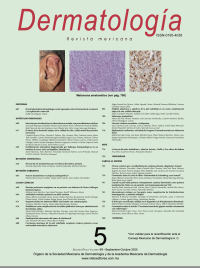Position and job category associated with training in solar protection in the working population of eight countries in Latin America.
Dermatol Rev Mex. 2019 mayo-junio;63(3):251-260.
Sherlyn M Buendía,1 Jason P De la Cruz,1 Olga M Enamorado-Leiva,2 Pablo José Lora-Acuña,3 Christian R Mejía1
1 Escuela de Medicina Humana, Universidad Continental, Huancayo, Perú.
2 ASOCEM UNICAH-SPSP, Universidad Católica de Honduras, Nuestra Señora Reina de La Paz, San Pedro Sula, Honduras.
3 Comité Estudiantil de Medicina, Universidad del Norte, Barranquilla, Colombia.
Resumen
OBJETIVO: Determinar la asociación entre el puesto y rubro de trabajo y la capacitación en protección solar en población laboral de ocho países de Latinoamérica.
MATERIAL Y MÉTODO: Estudio analítico transversal, de análisis secundario de datos, realizado de abril a junio de 2017. La población la constituyeron los trabajadores que manifestaron que se exponían a los rayos del sol mientras trabajaban, en ellos se midió si les habían dado charlas para la protección en este aspecto, lo que se comparó versus el puesto, rubro de trabajo de su empresa y otras variables socio-laborales. Se obtuvieron datos estadísticos de asociación.
RESULTADOS: De 3238 trabajadores, fue de 5 la mediana de años expuestos a la radiación solar (rango intercuartílico: 2-10 años) y 3 la de las horas de exposición al día (rango intercuartílico: 2-7 horas); Perú fue el país con mayor capacitación (54%). En el análisis multivariado se encontró que los que tuvieron menores frecuencias de capacitación fueron los que laboraban en el rubro de materia prima y se desempeñaban como estibadores; por el contrario, los que tuvieron más frecuencia de haber sido capacitados fueron los agricultores, personal de limpieza, ingenieros y el personal de salud.
CONCLUSIONES: Algunos puestos/rubros de trabajo y países descuidan las capacitaciones en esta temática, que es importante debido al comprobado factor de riesgo de los problemas dérmicos e, incluso, del cáncer.
PALABRAS CLAVE: Radiación solar; trabajadores; salud laboral; Latinoamérica.
Abstract
OBJECTIVE: To determine the association between the position and item of work and training in solar protection in working population of eight countries of Latin America.
MATERIAL AND METHOD: A cross-sectional of secondary analysis of data study was done from April to June 2017. The population was the workers that manifested that they were exposed to sunlight while they worked, in them it was measured if had received talks for protection on this aspect, being contrasted versus the position, job category of their company and other socio-labor variables. Statistics of association were obtained.
RESULTS: Of 3238 workers, the median of years exposed to the solar radiation was of 5 (interquartile range: 2-10 years) and 3 the hours of exposition a day (interquartile range: 2-7 hours); Peru was the country with the biggest training (54%). In the multivariate analysis it was found that the ones that had smaller frequencies of training were the ones that labored in the item of raw material and performed like dockworkers. On the contrary, the ones that had more capacitation were farmers, staff of cleanliness, engineers and the staff of health.
CONCLUSION: Some positions/job categories and countries neglect the trainings in this matter, that it is important due to the proven risk factor for dermic problems and even cancer.
KEYWORDS: Solar radiation; Workers; Industrial health; Latin America.

